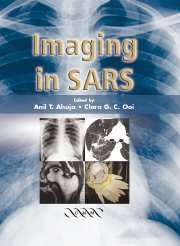Book contents
- Frontmatter
- Contents
- Contributors
- Preface
- 1 The Epidemiology of Severe Acute Respiratory Syndrome: A Global Perspective
- 2 The Role of Emergency Medicine in Screening SARS Patients
- 3 Severe Acute Respiratory Syndrome Outbreak in a University Hospital in Hong Kong
- 4 Imaging of Pneumonias
- 5 The Role of Chest Radiographs in the Diagnosis of SARS
- 6 Chest Radiography: Clinical Correlation and Its Role in the Management of Severe Acute Respiratory Syndrome
- 7 The Role of High-Resolution Computed Tomography in Diagnosis of SARS
- 8 The Role of Imaging in the Follow-up of SARS
- 9 Treatment of Severe Acute Respiratory Syndrome
- 10 SARS in the Intensive Care Unit
- 11 Imaging of Pneumonia in Children
- 12 Imaging and Clinical Management of Paediatric SARS
- 13 Imaging of SARS in North America
- 14 Radiographers' Perspective in the Outbreak of SARS
- 15 Implementation of Measures to Prevent the Spread of SARS in a Radiology Department
- 16 Aftermath of SARS
- 17 Update on Severe Acute Respiratory Syndrome
- Index
9 - Treatment of Severe Acute Respiratory Syndrome
Published online by Cambridge University Press: 27 October 2009
- Frontmatter
- Contents
- Contributors
- Preface
- 1 The Epidemiology of Severe Acute Respiratory Syndrome: A Global Perspective
- 2 The Role of Emergency Medicine in Screening SARS Patients
- 3 Severe Acute Respiratory Syndrome Outbreak in a University Hospital in Hong Kong
- 4 Imaging of Pneumonias
- 5 The Role of Chest Radiographs in the Diagnosis of SARS
- 6 Chest Radiography: Clinical Correlation and Its Role in the Management of Severe Acute Respiratory Syndrome
- 7 The Role of High-Resolution Computed Tomography in Diagnosis of SARS
- 8 The Role of Imaging in the Follow-up of SARS
- 9 Treatment of Severe Acute Respiratory Syndrome
- 10 SARS in the Intensive Care Unit
- 11 Imaging of Pneumonia in Children
- 12 Imaging and Clinical Management of Paediatric SARS
- 13 Imaging of SARS in North America
- 14 Radiographers' Perspective in the Outbreak of SARS
- 15 Implementation of Measures to Prevent the Spread of SARS in a Radiology Department
- 16 Aftermath of SARS
- 17 Update on Severe Acute Respiratory Syndrome
- Index
Summary
Background
Severe acute respiratory syndrome (SARS) is a newly emerged disease and the epidemic in Hong Kong came as a crisis. The clinical course of SARS appears to follow a triphasic pattern: phase I is clinically characterized by fever, myalgia and other systemic symptoms that generally improve after a few days. This is the phase when active viral replication occurs. Phase II is characterized by recurrence of fever, oxygen desaturation and radiological progression of pneumonia. The clinical progression during phase II appears to be related to immuno-pathological damage. The majority of patients recovered spontaneously but in some the disease progressed into phase III, characterized by acute respiratory distress syndrome (ARDS) necessitating ventilatory support (Figure 9.1). Reports show that with the development of respiratory failure and ARDS, 15–30% of patients will require intensive care admission.
Histological examination shows the presence of coronavirus particles in the alveoli of the infected lungs. Histopathology of post-mortem cases also reveal diffuse alveolar damage, pulmonary oedema, hyaline membrane formation and highly activated macrophages with haemophagocytosis. Thus, the treatment modalities should include antivirals, immuno-modulators and respiratory support at the different stages of the diseases.
- Type
- Chapter
- Information
- Imaging in SARS , pp. 89 - 98Publisher: Cambridge University PressPrint publication year: 2004

